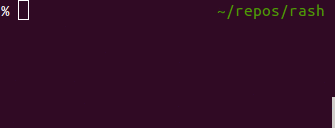Rash Advances Shell History¶
What is this?¶
Shell history is useful. But it can be more useful if it logs more data points. For example, if you forget which make target to run for certain project, you’d want to search shell commands that are run in particular directory. Wouldn’t it be nice if you can do this?:
rash search --cwd . "make*"
RASH records many data points and they are stored in SQLite database. Here is a list of recorded information [1].
- Current directory (
$PWD). - Exit code (
$?) - Exit code of pipes (
$PIPESTATUS/$pipestatus) - The time command is started and terminated.
- Environment variable (
$PATH,$SHELL,$TERM,$HOST, etc.) - Real terminal.
$TERMis used to fake programs. RASH can detect if you are in tmux, byobu, screen, gnome-terminal, etc. - Session information. If you go back and forth in some terminals, RASH does not loose in which sequence you ran the commands in which terminal.
| [1] | If you are curious, checkout rash record --help. |
RASH also has interactive search interface. You can see the search result as you type. If you are using zsh, you can execute the result instantaneously.

Install¶
RASH is written in Python. The easiest way to install is to use pip (or easy_install, if you wish). You may need sudo for installing it in a system directory.:
pip install rash
pip install percol # if you want interactive search feature
If you use virtualenv to install RASH, you may have trouble when switching environment. In that case, it is safe to make an alias to full path of the rash executable.:
alias rash="PATH/TO/VIRTUALENV/bin/rash"
If you want to use developmental version, just clone the git repository and add the following in your RC file.:
alias rash="PATH/TO/RASH/rash_cli.py"
Setup¶
Add this to your .zshrc or .bashrc. That’s all.:
eval "$(rash init)"
For more information, see rash init --help.
Usage¶
Searching history – rash search¶
After your shell history is accumulated by RASH, it’s the time to
make use of the history! See rash search --help for detailed
information. Here is some examples.
Forget how to run automated test for the current project?:
rash search --cwd . --include-pattern "*test*" --include-pattern "tox*"
All git commands you ran in one week.:
rash search --time-after "1 week ago" "git*"
Some intensive task you ran in the current project that succeeded and took longer than 30 minutes.:
rash search --cwd-under . --include-exit-code 0 --duration-longer-than 30m
What did I do after cd-ing to some directory?:
rash search --after-context 5 "cd SOME-DIRECTORY"
All failed commands you ran at this directory.:
rash search --cwd . --exclude-exit-code 0
Count number of commands you ran in one day:
rash search --limit -1 --no-unique --time-after "1 day ago" | wc -l
Showing detailed information – rash show¶
If you give --with-command-id to rash search command, it prints out
ID number for each command history.:
% rash search --with-command-id --limit 5 "*git*"
359 git log
1253 git help clone
1677 git help diff
1678 git diff --word-diff
1780 git merge
You can see all information associated with a command with
rash show command:
rash show 1677
Interactive search – rash isearch¶
Searching history using command line is not fast.
You can use rash isearch command to interactively search
history and see the result immediately as you type.
You need percol to use this feature.
Zsh user can setup a keybind like this:
# Type `Ctrl-x r` to start isearch
bindkey "^Xr" rash-zle-isearch
Defining this function in your rc file can be handy and it is usable for bash users.:
rash-isearch(){
eval "$(rash isearch)"
}
Dependency¶
RASH tested against Python 2.6, 2.7 and 3.2. However, as some dependencies are not Python 3 compatible, some functionality is missing when used with Python 3.
Python modules:
| [2] | (1, 2) These modules do not support Python 3. They are not installed in if you use Python 3 and related functionality is disabled. |
Platforms¶
- UNIX-like systems
- RASH is tested in Linux and I am using in Linux. It should work in other UNIX-like systems like BSD.
- Mac OS
- I guess it works. Not tested.
- MS Windows
- Probably no one wants to use a shell tool in windows, but I
try to avoid stuff that is platform specific. Only the
daemon launcher will not work on Windows but there is several
ways to avoid using it. See
rash init --help.
Shells¶
RASH currently supports zsh and bash.
Design principle¶
RASH’s design is focused on sparseness. There are several stages of data transformation until you see the search result, and they are done by separated processes.
First, rash record command dumps shell history in raw JSON record.
This part of program does not touches to DB to make process very fast.
As there is no complex transformation in this command, probably in the
future version it is better to rewrite it entirely in shell function.
Second, rash daemon runs in background and watches the directory to
store JSON record. When JSON record arrives, it insert the data into
database.
rash record and rash daemon are setup by simple shell snippet
eval $(rash init).
Finally, you can search through command history using search interface such as rash search. This search is very fast as you don’t read all JSON records in separated files.
+-------+ +--------+ +--------+ +--------+
| Shell | | Raw | | SQLite | | Search |
| hooks |-------->| JSON |-------->| DB |-------->| result |
+-------+ | record | +--------+ +--------+
+--------+
`rash record` `rash daemon` `rash search`
`rash show`
\------------------------------/ \------------/
`rash init` setups them search interface
License¶
RASH is licensed under GPL v3. See COPYING for details.
